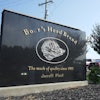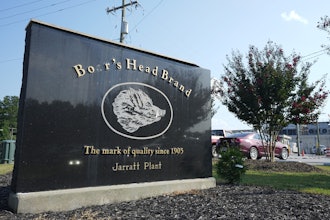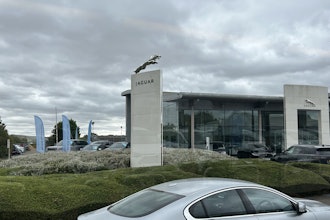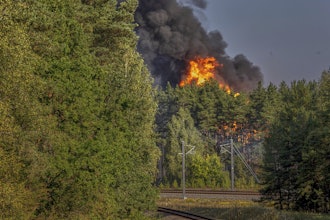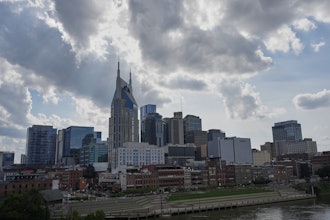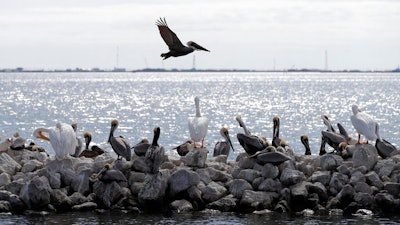
QUEEN BESS ISLAND, La. (AP) — A Louisiana island that provides a crucial nesting ground for pelicans and other seabirds is being restored to nearly its former size after decades of coastal erosion and a devastating offshore oil spill 10 years ago.
Gov. John Bel Edwards visited the island Monday, unveiling a sign dedicating it as a wildlife refuge.
“The walk we just made wouldn't have been possible a few weeks ago,” the governor said after crossing an expanse of sand bearing tread marks from heavy equipment used to create and grade new land. He spoke at a podium set up before waist-high mangroves, which contractors left untouched for pelicans to nest on.
About 6,500 brown pelicans and 3,000 smaller seabirds cram their nests every summer onto Queen Bess Island, which shrank from 45 acres (18 hectares) in 1956 to about 15 acres (6 hectares) of marsh by 2010, when the Deepwater Horizon spill fouled its beaches with oily gunk.
Until the restoration, only about 5 acres (2 hectares) — most of it along the island's edges and the outlines left by short-lived restorations in the 1990s — was high enough for pelicans to nest, said Todd Baker, a biologist supervising restoration for the Louisiana Department of Wildlife and Fisheries. Once a mere strip of land, the island now covers 37 acres (15 hectares), with most of it for the increasingly cramped birds.
Edwards said the $18.7 million project to enlarge and maintain the island is part of $550 million that that has restored more than 4,200 acres (1,700 hectares) of Louisiana's coast and islands. More than $800 million in additional work is expected across Louisiana this year, he said.
Though barely a blip of an island off the Gulf of Mexico in Barataria Bay, Queen Bess plays an outsize role as one of Louisiana's largest rookeries for brown pelicans, supplying real estate for up to a fifth of the state's nests. It's also where the pelican, Louisiana's state bird, was reintroduced in the 1960s after pesticides had killed off the state's entire population.
Loss of the small islands where pelicans nest has crowded the big birds into about 10 colonies, fewer than half the number in 2010, Baker said. “When you're a tiny island you're on the front lines of sea-level rise and coastal erosion.”
Funds to restore Queen Bess Island and for future monitoring and upkeep flow from a $20 billion settlement that the federal government and the five Gulf Coast states reached with energy giant BP PLC for environmental damage from the 2010 spill.
The offshore explosion and fire that year on BP's leased drilling rig killed 11 people. The well spewed more than 100 million gallons (378 million liters) of oil into the water over 87 days.
When the oil reached the island about 45 miles (72 kilometers) south of New Orleans, more than 1,000 birds died. Brown pelicans and other birds could be seen struggling, their wings weighed down by black muck.
Contractors for Louisiana's Coastal Protection and Restoration Authority enlarged the island by dredging up Mississippi River sand and pumping it inside the outlines of rock and other material from the 1990s restoration, which used silt. The sand, designers hope, will be more stable. The authority also built a line of rock breakwaters 75 to 95 feet (23 to 29 meters) from shore to slow erosion and provide calm water for young birds.
Most of the island is being restored as a pelican habitat, with 7 acres (2.8 hectares) for skimmers, terns and other birds that nest on rocks.
In recent years, Baker said, nests have been so jammed “you can't hardly step on land without touching a nest.”
He said the crowding has made the island's woody plants look like apartment houses, with nest above nest above nest: perhaps a laughing gull on the ground, an egret or roseate spoonbill in middle branches and a brown pelican nest at the top.
“It was cool to look at but not necessarily good for those birds,” Baker said.
In an assist to the birds, The Louisiana Wildlife and Fisheries Commission designated the island a wildlife refuge in November. The commission is taking comments on rules that, among other things, would forbid people from stepping on the island during the eight-month nesting season.
Restoration work should be completed by Feb. 15, Baker said. He added that remaining work includes creating ramps for young birds that still can't fly so they can walk in and out of the water.
Contractors also will plant about 24,000 woody plants for species including night herons and egrets and pelicans to build their nests. Those are still essentially 3-foot-high (1-meter-high) sticks, Baker said. He noted that while pelicans prefer nesting on scrub-shrubs, they can also build nests on grass or even bare ground. The ground-nesting terns, skimmers and gulls are expected to use the expanses of bare sand between the plants as well as the rocky area created for them.
Most important for Baker: Will pelicans return to the island where they built nests or were hatched? Five hundred were banded last year to help him and other conservationists answer that question.


